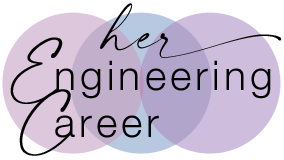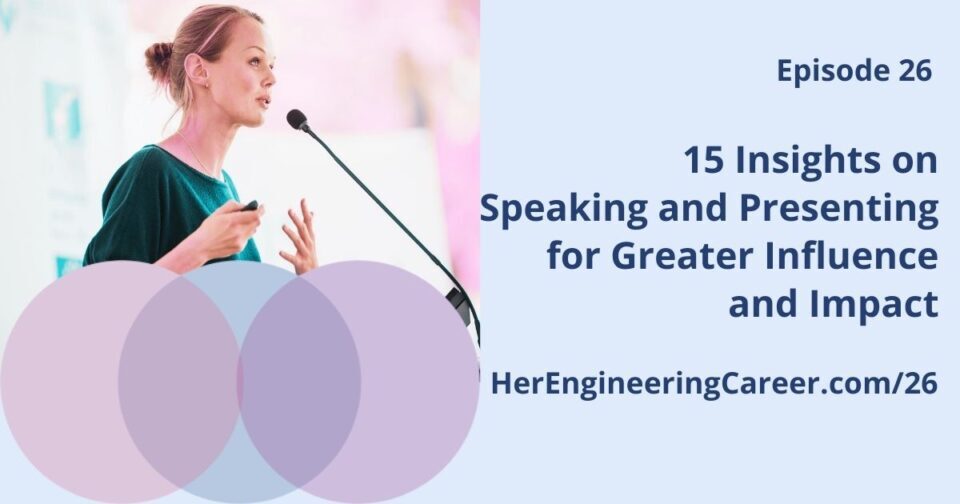Show Notes
In this episode I’m presenting a set of insights for women engineers about speaking and giving presentations. Important things to know in highlight format. Let’s jump right in.
- Fact: You will give many presentations as part of your engineering career.
- There’s a huge range of presentation types. Pay attention to the potential for each one and what the outcome means. This will give you an idea of how much time and effort to put into it.
- If you’re a person who gets locked in fear when you find out you’re giving a presentation, a change in perspective might help. Think of yourself not as a presenter or a speaker, but instead as a teacher, a helper, or a giver.
After all, you’re giving something to your audience, you’re helping them with what they need. You’re teaching them new ideas. I find this perspective to be less stressful.
- How to improve your presentation skills can be summarized in one word: practice. Practice with yourself; practice in front of a mirror; or videorecord yourself. You can practice with a friend or colleague or mentor.
You can also take a training class, work with a coach, work with a group (like an employee resource group or an affinity group), or join a club (like Toastmasters).
- It’s a good idea to practice giving off-the-cuff or on-the-spot presentations, too. Because sometimes you don’t have time to prepare. Sometimes you get asked a question and you must present an answer now.
And sometimes the 20-minute timeslot for your presentation gets compressed down to 5 minutes – and you still have to get your point across.
- Your presentation will be successful if you can do these 3 things:
- Organize your talk for audience understanding.
- Craft the key message you want them to take away.
- Focus on that message and present it in a meaningful way.
- Obviously, your presentation should be smooth, with no jargon, and no ums, ahs, or likes. Be out in front of the audience, if possible, instead behind the podium. Don’t read your presentation. Have good stature, sound and eye contact.
Oh yes, and don’t use the word “obviously” because it’s never obvious to anyone but you.
- Here’s your first tip:
Have a strong opening and closing.
Having a strong opening is important because it serves as the entryway into your presentation, helps the audience get into the topic and prepare for your message, and helps you get through the opening jitters and get into the flow of your presentation.
Write it out and practice it so you can give it without thinking too much. Your presentation will stand out with a strong opener.
Having a strong closing is important because it indicates the end of your presentation while keeping you from awkwardly fading out or dropping off. It signals that the presentation is complete and it’s time to go to the Q&A or whatever’s next on the agenda.
IMO a firm closure makes you stand out as more professional and credible.
To learn more about how to create a strong opening and closing, go to my website and book a Strategy Session with me. I’m ready for you. We will change your presentation from good to awesome.
- Not surprisingly, in most of your presentations you’ll use slides. Slides should be readable, consistent in format, not too wordy, and complementary to your presentation.
You and what you have to say are most important and your slides accompany you (with pictures, charts, graphs, and highlights). Don’t make your audience have to choose between reading the slides and listening to you.
- We are engineers and we like data and information. But relaying data and information effectively means making the human connection to your audience. Especially if your audience is unfamiliar with your technology area or your topic.
So watch the jargon, see your topic from your listeners’ perspective, use your storytelling skills, and share personal anecdotes.
A good example: when presenting your engineering work be able to show benefits and real life applications in terms your audience understands.
- Okay, yes, there are times where it’s better to focus on the data and the information and not the fluffy stuff (the stories, personal anecdotes, etc.). Usually these are emergency or safety situations – when people just need to get the facts and go.
But sometimes they are just deep geek situations. When everyone in the group is intimately familiar with the technology and the on-going work, you can limit your presentation to data and information. But these are the exceptions, not the rule.
- Everyone has their own process for preparing for a presentation. Here’s mine:
- First, I create and organize. I write out what I want to say in a meaningful format for my audience. I also create the slides.
- Second, I edit and refine. I take out any unneeded extra words and focus on the message. I make sure the message I want the audience to hear and take away with them is emphasized.
- Third, I practice. To make sure the message gets across.
- Fourth, I practice more. To make it smooth.
- Fifth, lastly before presenting, I prepare mentally. Usually through meditation, breathing, and relaxation. The wonder woman pose helps, too.
- Sixth, I try to be authentic and focus on the message as I give the presentation.
- And seventh, after the presentation I ask for feedback (that I can use in preparing for my next presentation).
- BTW, I can tell during a presentation when I kick into flow. It’s the point after my opening jitters when my passion for the topic and my focus on the message engage. Here I know I’m doing well. It feels good. Very authentic.
- Don’t forget to read your audience. You can tell if they’re bored, confused, not having it; or if they’re soaking it in, getting it, appreciating it.
Sometimes you can make adjustments real time in response to your audience. You can slow down, speed up, skip a section, or re-explain something. Other times you just have to make a mental note and change something for next time.
- Here’s your second tip:
Make the most of your time as an audience member.
You do spend a lot of time presenting. But you spend more time listening to other presenters. So use that time to observe. You can learn a lot from this vantage point.
See what speakers do that you like and don’t like. See how well they get their messages across. Observe the smooth and not-so-smooth deliveries.
Also notice the perspective you have of each speaker and perhaps how calm and focused they are. How would you do in their shoes? Picture yourself calm and focused in your next presentation, maybe borrowing some of their effective methods and approaches.
And that’s it. 15 insights for speaking and presenting for more influence and impact. Moreso than the topic of your presentation, how you present affects your career visibility, recognition, and opportunity.
Be aware of how each presentation can have an impact. On your audience of course, but also on you and your engineering career.
Coming up on Her Engineering Career Podcast we’ll have a series of short episodes, some quick tips and helps and how-tos that are simple but give a significant lift to your engineering career. Join me next time for Episode 27.

